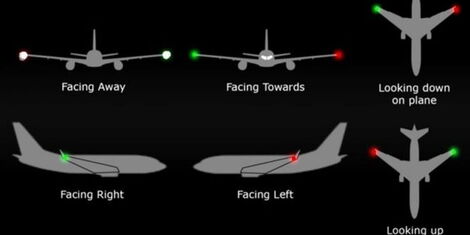The invention of the aeroplane by the Wright brothers, Wilbur and Orville, remains arguably the most disruptive in the transport industry.
More than 100 years since the first plane took off, several modifications have been made to improve the efficiency of planes and the comfort of air travel.
Among the improvisations was the introduction of lights on the fuselage, the body of an aircraft. Kenyans.co.ke looked at the eight types of lights and their functions.

The lights are categorised into three sections depending on their functions which include increasing the pilot’s visibility, increasing the visibility of the aircraft and for other general purposes.
Lights to improve the visibility of planes
Navigation lights: These lights increase the visibility of the plane to other pilots in the airspace and staff working in the airports. These include a red light at the left wing tip, green on the right wing tip and white on the tail.
The three sets of lights help tell the direction in which the aircraft is moving either on the runway or during a flight.
Beacon Lights: These are the red flashing lights located at the top and bottom of the fuselage. Pilots turn them on manually in the cockpit before they start the engine and turn them off when the engine goes off.
Strobe lights: Strobes are high-intensity lights installed on the wing tips and tail of the plane. Captains turn them on when approaching the runway for take-off and turn them off when exiting the runway after landing.
Pilot Visibility
Taxi lights are installed on the nose or landing gear of the plane. They serve like vehicle headlights and illuminate the path of the plane.
Runaway turn of lights compliments the taxi lights. They are mounted above the landing gear at an angle to light the front left and front lights of an aircraft path.
Landing lights are high-intensity lights turned on during take-off, landing and when the aeroplane is airborne to illuminate the flight path.
Wing inspection lights are mounted on the left and right-hand side of the fuselage or on each wing. Pilots use them to check on ice formation on the aircraft before take-off or when airborne.

General purposes
These include logo lights mounted on the rear wings of an aircraft. They are angled towards the tail of an aircraft to illuminate the logo of the airline operating the aircraft.
Source: kENYANS.CO.KE











